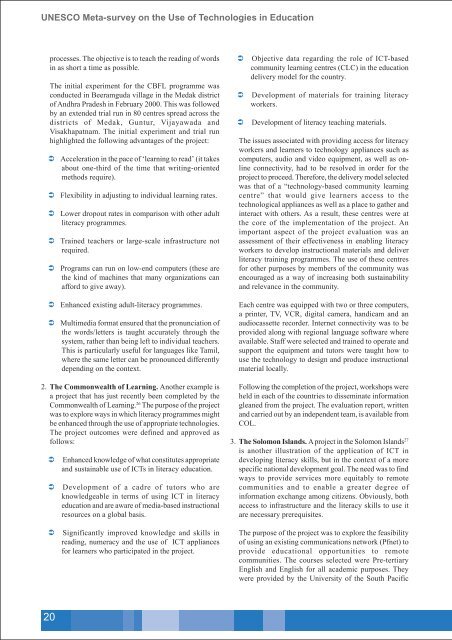Download (PDF, 2.MB) - UNESCO Bangkok
Download (PDF, 2.MB) - UNESCO Bangkok
Download (PDF, 2.MB) - UNESCO Bangkok
- No tags were found...
Create successful ePaper yourself
Turn your PDF publications into a flip-book with our unique Google optimized e-Paper software.
<strong>UNESCO</strong> Meta-survey on the Use of Technologies in Educationprocesses. The objective is to teach the reading of wordsin as short a time as possible.The initial experiment for the CBFL programme wasconducted in Beeramguda village in the Medak districtof Andhra Pradesh in February 2000. This was followedby an extended trial run in 80 centres spread across thedistricts of Medak, Guntur, Vijayawada andVisakhapatnam. The initial experiment and trial runhighlighted the following advantages of the project:Acceleration in the pace of ‘learning to read’ (it takesabout one-third of the time that writing-orientedmethods require).Flexibility in adjusting to individual learning rates.Lower dropout rates in comparison with other adultliteracy programmes.Trained teachers or large-scale infrastructure notrequired.Programs can run on low-end computers (these arethe kind of machines that many organizations canafford to give away).Objective data regarding the role of ICT-basedcommunity learning centres (CLC) in the educationdelivery model for the country.Development of materials for training literacyworkers.Development of literacy teaching materials.The issues associated with providing access for literacyworkers and learners to technology appliances such ascomputers, audio and video equipment, as well as onlineconnectivity, had to be resolved in order for theproject to proceed. Therefore, the delivery model selectedwas that of a “technology-based community learningcentre” that would give learners access to thetechnological appliances as well as a place to gather andinteract with others. As a result, these centres were atthe core of the implementation of the project. Animportant aspect of the project evaluation was anassessment of their effectiveness in enabling literacyworkers to develop instructional materials and deliverliteracy training programmes. The use of these centresfor other purposes by members of the community wasencouraged as a way of increasing both sustainabilityand relevance in the community.Enhanced existing adult-literacy programmes.Multimedia format ensured that the pronunciation ofthe words/letters is taught accurately through thesystem, rather than being left to individual teachers.This is particularly useful for languages like Tamil,where the same letter can be pronounced differentlydepending on the context.Each centre was equipped with two or three computers,a printer, TV, VCR, digital camera, handicam and anaudiocassette recorder. Internet connectivity was to beprovided along with regional language software whereavailable. Staff were selected and trained to operate andsupport the equipment and tutors were taught how touse the technology to design and produce instructionalmaterial locally.2. The Commonwealth of Learning. Another example isa project that has just recently been completed by theCommonwealth of Learning. 26 The purpose of the projectwas to explore ways in which literacy programmes mightbe enhanced through the use of appropriate technologies.The project outcomes were defined and approved asfollows:Enhanced knowledge of what constitutes appropriateand sustainable use of ICTs in literacy education.Development of a cadre of tutors who areknowledgeable in terms of using ICT in literacyeducation and are aware of media-based instructionalresources on a global basis.Following the completion of the project, workshops wereheld in each of the countries to disseminate informationgleaned from the project. The evaluation report, writtenand carried out by an independent team, is available fromCOL.3. The Solomon Islands. A project in the Solomon Islands 27is another illustration of the application of ICT indeveloping literacy skills, but in the context of a morespecific national development goal. The need was to findways to provide services more equitably to remotecommunities and to enable a greater degree ofinformation exchange among citizens. Obviously, bothaccess to infrastructure and the literacy skills to use itare necessary prerequisites.Significantly improved knowledge and skills inreading, numeracy and the use of ICT appliancesfor learners who participated in the project.The purpose of the project was to explore the feasibilityof using an existing communications network (Pfnet) toprovide educational opportunities to remotecommunities. The courses selected were Pre-tertiaryEnglish and English for all academic purposes. Theywere provided by the University of the South Pacific20
















